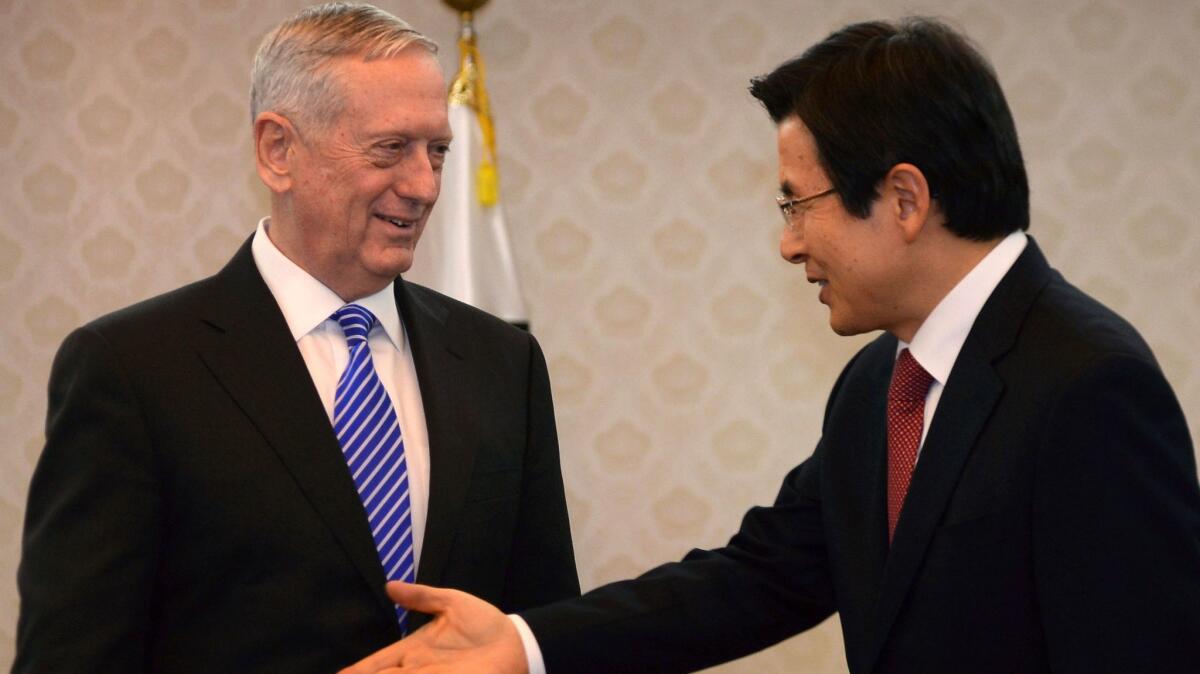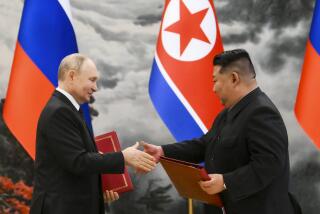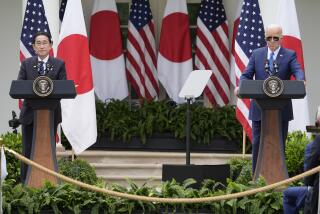Mattis arrives in South Korea to reassure nervous U.S. ally

- Share via
Reporting from seoul — America’s top defense official was expected to confront thorny policy issues in Asia — including North Korea’s advancing nuclear program and a planned missile defense system that has angered China — during his first official foreign trip.
But a key goal for Defense Secretary James N. Mattis, analysts said, was assuring South Korea and Japan that bonds with the United States would remain strong despite tough rhetoric from its new president, Donald Trump.
Mattis so far has tried to deliver.
On the flight to South Korea, the retired Marine Corps general described the alliances between the two countries as “enduring.” Later, in a meeting Thursday with South Korea’s acting leader, Hwang Kyo-ahn, Mattis promised to continue a united effort to confront North Korea.

Acting South Korean President Hwang Kyo-ahn, right, greets Defense Secretary James Mattis prior to their meeting Feb. 2 in Seoul.
“We have to address the reality of the threat that your country and my country faces,” Mattis said, according to a small group of reporters assigned to document the encounter. “We intend to be shoulder to shoulder with you as we face this together.”
On Friday, Mattis used stronger language, saying the United States would use “effective and overwhelming” force if North Korea attacked either country with nuclear weapons.
The trip was seen by many as a signal that the Trump administration’s foreign policy would focus on Asia. The effort was beginning in South Korea, where Mattis also visited the headquarters for U.S. troops stationed here.
Though few specific details about the discussions have been made public, observers expected that he might face concern about the Trump administration’s strong “America first” foreign policy, as announced at the inauguration, and whether it might ask for more money to continue security arrangements in the two countries.
“You have high levels of anxiety and uncertainty in Asia, but especially in South Korea and Japan, about where they stand under Trump,” said John Delury, an associate professor at Seoul’s Yonsei University.
In addition to offering reassuring comments, Mattis was expected to focus his talks on readiness and coordination in dealing with North Korea.
Besides its nuclear threat, which includes bombs and a growing capacity to deliver them, the rogue state already has large numbers of conventional forces and artillery within striking distance of the 20-plus million people who live in and around Seoul.
Mattis capped his visit by meeting Friday with South Korean Defense Minister Han Min-koo, during which he offered a stern warning aimed at North Korea.
“Any attack on the United States, or our allies, will be defeated, and any use of nuclear weapons would be met with a response that would be effective and overwhelming,” he said.
Han welcomed Mattis’ statement, saying it was evidence of the allies’ defensive cooperation on the nuclear issue.
“It serves as a strong warning to Pyongyang,” he said.
The talks come as the countries next month are scheduled to carry out joint military exercises, which sometimes prompt reactions from the North.
It’s unclear, though, how Trump’s administration would handle a major provocation, such as a nuclear test or long-range missile test — perhaps another item on Mattis’ agenda.
At the Friday meeting, Mattis and Han discussed South Korea’s deployment of the Terminal High Altitude Area Defense system, a U.S.-designed defensive array intended to counter ballistic missile threats from North Korea.
Both leaders announced that the system would be deployed on South Korean soil by the end of 2017.
The system relies on wide and sophisticated radar, prompting China to complain about its national security interests — concerns Mattis has said are unfounded.
Mattis encountered a supportive banner as his motorcade approached his hotel on Namsan, a mountain landmark in Seoul adjacent to the main American military presence here.
But not everyone welcomed the visit, which comes as South Korea is paralyzed politically. Its president, Park Geun-hye, had her duties suspended last month after impeachment over corruption allegations. She could be permanently removed from office this spring.
Some of the people Mattis talks with on the trip might exit too.
The missile system remains a sore spot for some here. Peace protesters have gathered almost daily for months in front of the Defense Ministry to complain about it. And a large group gathered in a central square Thursday to protest Mattis’ arrival. One held a sign that read, “‘Mad Dog’ Mattis — Not Welcome in Korea.” More protesters were expected Friday.
As the new U.S. administration defines how it will deal with North Korea, the United States has more than 80,000 forces stationed in Japan and South Korea. But questions of how to pay for them — or at least the size of America’s cost share — was an issue Trump raised in the campaign, further adding to the allies’ uncertainty.
It will be Mattis’ role, some have speculated, to ease worries about those statements.
“He wants to reassure the South Korean government that the United States isn’t going to immediately, or even eventually, withdraw its forces from the peninsula,” said Peter Kim, who teaches U.S.-Korea relations at Kookmin University. “America is here to stay, contrary to what candidate Trump said during the presidential election last year.”
The political situation in Japan is more stable, but the nation’s long-sputtering economy took a hit after Trump announced he was abandoning the Trans-Pacific Partnership, a trade deal between multiple nations that Tokyo had sought.
Both South Korea and Japan have concerns about China, which has reportedly cooled economic and diplomatic ties with South Korea in recent months over the missile system.
Japan, where Mattis was set to travel later Friday, has its own concerns about North Korea’s nuclear and missile capabilities. It is also seeking assurances about its dispute with China over its claim to the Senkakus, a series of uninhabited islands in the East China Sea.
While in Tokyo, Mattis could also help lay some groundwork for Japanese Prime Minister Shinzo Abe’s visit this month to Washington, where Trump’s vision for America’s Northeast Asia policy could be explained in more detail.
Stiles is a special correspondent.
ALSO
In Asia, China looks like the winner after scuttling of Trans-Pacific Partnership
New Secretary of State Rex Tillerson already has fences to mend — with his own diplomatic corps
UPDATES:
Feb. 3, 5:55 a.m.: This article was updated with additional details and quotes from Mattis’ meetings.
9:45 p.m.: Updated with the announcement on the Terminal High Altitude Area Defense system.
This article was first published on feb. 2 at 7:50 a.m.
More to Read
Sign up for Essential California
The most important California stories and recommendations in your inbox every morning.
You may occasionally receive promotional content from the Los Angeles Times.











